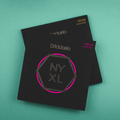GARY MOORE
By Strings Direct – 29 August, 2023
PLAYER SPOTLIGHT
The Definitive Blues Power Icon 🎸

This feature stars a personality that thundered through the world of guitar players. A player whose presence, note choice and sheer delivery was undeniably phenomenal. A musician with full frontal attitude and emotion that was laid into his signature playing style note by note.
Iconically exciting and exhilarating to witness live, this player pushed many boundaries but remained a guitar player's guitar player. Making the extraordinary ordinary his abilities were conveyed as both effortless and prodigy of the modern day. A man who truly admired, respected, and coveted the history of Guitar.
Myth and legend the explosive boom Mr Gary Moore.
Walkin’ With The Blues

Perceived as one of the greatest players of our generation it will come as no surprise that this weeks Player Spotlight has the upmost respect and admiration for this very talented individual. Ultimately he is one of the greatest guitarists this country has ever produced.
Hailing from Belfast, Northern Ireland, Robert William Gary Moore was born in April 1952. One of four siblings born to Winnie and Robert Moore.
Gary always credited his father as his first & key musical influence; Gary's father Robert worked for the Queens Hall Ballroom as a promoter. Gary’s most memorable moment defining his musical pathway was being on stage at 6-years-old invited when he was invited to sing "Sugartime" with a showband at an event his father had organised, which first sparked his interest in music. His father later bought him his first guitar - a second-hand Framus acoustic - when Moore was 10-years-old.
Although left-handed, he learned to play the instrument right-handed.
“Part of what made Gary Moore such a brilliant blues guitarist was the way that he studied the genre and learnt from the early masters. His influences included blues guitarists as diverse as B.B. and Albert King, Albert Collins and Peter Green. In fact both Albert King and Albert Collins played on Moore’s album Still Got The Blues, and Gary Moore recorded Blues For Greeny – a whole album dedicated to his friend and mentor Peter Green.
Gary Moore studied these players and learnt from them. But crucially, he blended their techniques and style with his own, to develop his own voice.”
https://happybluesman.com/10-lessons-learn-from-gary-moore/
“I started listening to all the Blues guys, like B.B. King and Albert King. It still goes back to those guys, and I think my playing is a combination of all of those elements, but at some point it came together and became my own style”
Gary Moore - happybluesman.com
Like many guitar players within that era Gary had similar key moments, key players and inspirations that would be his staple musically and professionally.
He described the significance and sheer power that the "Beano Album" had on him and many others at the time.
“I’d been playing for five years when that came out,” he told this writer in 2004, “and I heard Eric using that Les Paul/Marshall combination. He kind of invented rock guitar as we know it – playing the blues with that edgy, aggressive tone. Then I heard Jeff Beck and Peter Green, and that’s where it all came from for me.”
Gary Moore - https://www.guitarworld.com/features/gary-moore-blues-rock-guitar

“In 1966, Gary was just 14, already a self-professed ‘Blues snob’, and playing guitar in local bands in his hometown, Belfast. He would regularly share a stage – and guitars and amps – with another upcoming player, Rory Gallagher. Clapton’s new sound hit Moore hard.”
https://www.guitarworld.com/features/gary-moore-blues-rock-guitar
Rock Star ⭐️ Recruit & Machine Gun Riffs
Gary quickly formulated into a well-respected young player and moved around the scene and admired the greats from both close and afar. He went on to have a career spanning from the 60s until ultimately his death in 2011.
His journey started in the sounds of the 60s with the contemporary Blues, he then progressed into various styles and projects moving from Blues, to rock, to jazz, and fusion.
Whatever style he was playing his individuality always seemed to shine through, he has such an easily identifiable sound playing and style that is admired by many and earns him the right to be defined as a guitar virtuoso. The emotion is heavy in his playing and really cuts through.
“While he is well-known for his contributions as a member of Thin Lizzy, Moore maintained a successful solo career which began before he was enlisted to play with the group, and continued doing so between his stints with Lizzy.”
Quote Reference - Lisa Sharken - vintageguitar.com
I recall the first time I saw Gary Moore playing live on the television 📺 when I was much younger. Anybody who’s old enough to remember the great channel VH-1, will recall they used to do these half-an-hour live session showcases on artists. I was aware vaguely of who Gary Moore was from his image on guitar magazines at the time. But seeing this mind-blowing performance he had my full attention and always has ever since.
The intense velocity of his playing, the aggression, the technique, combined with the freedom and the emotions he was able to convey into each individual note or expression was phenomenal to witness.
“Gary's first band of note, the power trio Skid Row, secured a record deal with the CBS label in 1970. By this time, Gary had moved to Dublin, and befriended a certain Philip Lynott, who filled the vocal role with Skid Row until shortly before the CBS deal was signed. Gary cut three albums with the band, and toured the USA supporting The Allman Brothers Band, and Mountain amongst others, before he left Skid Row to embark on a solo career. This proved short-lived, as Gary was soon to reunite with Phil Lynott as replacement for Eric Bell in the Thin Lizzy line-up. Although he was in the band for a relatively brief tenure, he would re-join their ranks following the departure of Brian Robertson in 1977, and again, finally as a full band member, for the 'Black Rose' album and tour in 1978.“
http://www.gary-moore.com/history/biography.html
A key personal event in Gary's life that actually altered his personality, confidence and some say playing was the following incident.
“In the mid-1970s, Moore was involved in a bar fight which left him with facial scars. According to Eric Bell, Moore was with his girlfriend at Dingwalls when two men "started mouthing about Gary's girlfriend. After Moore confronted them about it, one of the men smashed a bottle on the bar and slashed his face with it.
This had a profound effect on him. Bell said, "It did change him. A lot of that pent-up anger and emotion would come out in his playing. And it came out in other ways too. It must be a hard thing to come back from something like that." During the 1980s, he would hide his scars in photographs and videos by looking down or being framed from a distance.”
https://en.wikipedia.org/wiki/Gary_Moore

The following statement from guitarnoise.com completely defined Gary Moore as a player this "captures everything about him and everything I as a player think about him.
“No matter the genre, one thing is evident – Gary Moore doesn’t play for you, he plays to you. Gary’s solos are not simply instrumental breaks in the middle of a song. They drive the song forward, with intention, and are an integral piece of the puzzle. The lion’s share of the songs chosen for this tribute come from Gary Moore’s first few solo albums; they were originally recorded by Moore when most of the musicians involved here were still learning to play. Chris Poland, guitarist for Megadeth and Ohm, contributed to Parisienne Walkways on this release and remembers, ‘The first time I ever heard Gary Moore, I just couldn’t believe his guitar tone, and how fearless he was. It’s that same fearlessness that Jeff Beck has. When Gary Moore’s done with a solo, you’re kind of breathless.”
https://www.guitarnoise.com/artists/gary-moore/

The Les Paul … Green Legend

(Image credit: Brian Rasic/Getty Images)
There are a number of very iconic, significant and famous guitars in the world, these particular guitars are defined by their history: who used them, when, where and why.
I don't believe there is a more significant guitar within guitar culture than the 1959 Les Paul Standard originally owned by Peter Green. This guitar comes to a truly magical and mystical place that seems to be timeless with its exquisite tone and musical magic.
Gary had met Peter several times and they had become regular acquaintances; Gary used to stand in absolute awe and admiration as a younger person watching Fleetwood Mac.
Both iconic guitar players became good friends, in fact Peter came to see Gary to tell him he was leaving Fleetwood Mac - an incredible expression of friendship and bond between two musicians that he would release such information to Gary.
"Peter called me up and said, ‘What do you think of the guitar?’ And I said, ‘Well, it’s fantastic.’ He said, ‘Do you want to buy it?’ He wanted it to have a good home"
Gary Moore - https://www.guitarworld.com/features/how-gary-moore-came-to-own-peter-greens-iconic-les-paul-greeny
The initial gesture was that Gary was given the guitar to borrow as Peter wanted to lend it to him so he could try, and get a feel for it, and understand it as a player.
Gary looked at the chance and couldn't believe what was actually happening.
Peter Green being the personality he was, was more interested in the guitar having the right home rather than being sold for the right money. Peter told Gary to sell his main guitar and use whatever he got for it in exchange for the Les Paul; it would just be like swapping! He declared he would never ask for the guitar back "I just wanted it to be right."
The whole process of passing down iconic instruments clearly wasn’t recognised as a gigantically spiritual event at the time, but now it's seen as an epic passing of the torch by us... The Fans.
The end result was quite astonishing… but also one of the coolest Rock 'n' Roll moments in history.

“Gary told Peter that he didn’t think he could afford it, but Peter remained insistent that he wanted Gary to be Greeny’s new owner. “He said it wasn’t the money he was interested in, he just wanted it to have a good home,” says Gary. “So he told me to take my main guitar and sell it and whatever I got for it I could give to him, so it would be like swapping guitars.
I had an SG at the time and so I took it into town and I sold it for £160 or something and he came up to my flat for the money and gave me 40 or 50 quid back! He said, ‘I’ll tell you what, I’ll just take what I paid for it, which was 120 quid.’
I think I ended up giving him £100 or £110. I said to him if he ever wanted it back I’d give it to him, but he said, ‘No, I’ll never ask for it back…”
https://www.guitarworld.com/features/how-gary-moore-came-to-own-peter-greens-iconic-les-paul-greeny

(serial number: 9-2208)
Image - https://squidguitarinc.wordpress.com/2015/08/15/the-peter-green-gary-moore-les-paul/
Bluesman's Wires
So we come to the penultimate moment where we look to investigate the tools of the magician, or more specifically the consumables attached. What do we expect from a blues-rock guitar player? A certain tone, a certain attack, the right feel with dynamics to the sound.
Gary Moore has always been quite open about the gear he uses on stage: guitars, amplifiers, everything and has kept the consistency through to strings.
For many years he credited Dean Markley within his album sleeves, he had been quoted stating his commitment to these particular strings.
"I string my guitars with Dean Markley's—sometimes .010-.052, and sometimes a .009-.048 set. Honestly, I only hear the difference in gauge on the bottom strings, not the top."
Gary Moore, October 1, 2007, Guitar Player Magazine”

“Let’s get specific about your preferences for the way your guitars sound and feel. How are they set up?
I don’t like really low action because it starts to get a bit “chinky” sounding. I used to use heavier strings, but a couple of years ago I injured my hand and I had to go down a gauge. I use .009-.048 now and I was using .010-.052 before. But I’m actually working my way back up again. I started with .009-.046 and I’m trying to work my way back up to .050 again. I think the tone is more noticeable in the bottom strings.”
Gary Moore for Lisa Sharken - vintageguitar.com
Here at Strings Direct we've created a few custom 'Gary Moore-inspired' sets based on Gary's preferences, we find the gauges and construction (Nickel plated Steel / roundwound to be more significant than anything else, but of course if you do want to get as close as possible then please contact us and we can put a special order in to Dean Markley to get you on those Parisienne tonal walkways …. 😎
* * * * *
REFERENCES
http://www.gary-moore.com/history/biography.html
https://www.guitarworld.com/artists/the-secrets-behind-gary-moores-tone-on-still-got-the-blues
https://www.vintageguitar.com/3481/gary-moore-3/
https://www.groundguitar.com/gary-moore-gear/gary-moores-dean-markley-electric-guitar-strings/
https://www.guitarworld.com/features/gary-moore-blues-rock-guitar
https://www.guitarnoise.com/artists/gary-moore/





